Hockey drills for technique hitting
- Player A plays the ball to Player B, who comes running into the ball.
- Player B bounces the ball directly back and runs towards the corner edge circle with a slalom through the gates.
- Player A runs towards the first pole to perform a tip in
Exercise is set up in the middle.Player A becomes player B and vice versa.
- The trainer (T) rolls the ball (1) to one of the four front players (for example A).
- Player A receiving the ball (2) plays a duel with player V1 opposite him.
- The goal is to score the ball at the opponent's goal.
- If V1 manages to intercept the ball, he plays it to V2.
- Now V2 may try to score with player B.
- After a goal, the form of play starts over again.
Making it easier
- Play a 1-1 duel on the two fields for a few minutes, after a goal, the substitute player comes into play.
Make it more difficult
- After the ball is taken by V1, V1 and V2 may try to score against player A (now it has become a 2-1 game).
- A has to defend.
- If A takes the ball, he plays it to player B.
- Player A and B play a 2-2 duel on players V1 and V2.
- It works just like a normal game only now there's a square in the middle.
- If a shot or other foul is made, or if the ball has been out of bounds, the trainer throws/plays in a new ball from inside the square.
- The ball does not necessarily go to the same team or at the place where the foul was made.
- The size of the field depends on the number of players.
- Player 1 plays the ball to player 2 after which player 1 runs through
- Player 2 bounces the ball back to Player 1,
- Player 1 aligns the ball between the pilons (The player is not going to run into the "pilon box".)
Player 1 then finishes the ball at goal
You can speed up this exercise by placing the mirrored exercise on the other side, allowing you to play from 2 sides.
Aim:
To become physically as well as technically warm as preparation for the training.
Set up:
The exercise will be done with a maximum of 4 people. Of course you can put a multiple of these so that the exercise still works.
1. The players 1 start with the ball and play it to their players 2. Then they change positions.
2. Players 2 play the ball back to players 1 and also change positions.
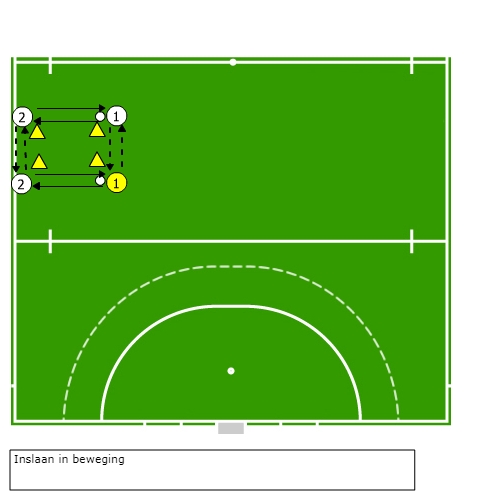
Variations:
- You can vary the way of passing (hitting, push, flats)
- Increase the distance between the pilons that players only has to run further.
- Increase the distance between the pilons that players have to pass over longer distances
- Increase both distances.
- Increase speed.
- Make as many successful passes as possible in time.
Points of attention:
- Sit low for a good control.
- Stick to the ground at ball control.
- Play the ball on the forehand side.
- Stand still while performing a ball control.
- Person 1 dribbles with the ball, does a 3D trick
- and passes a backhand to player 2 while running.
- Player 2 passes the ball to player 3 in the run.
- He dribbles along the obstacles and does a 3D trick at the end,
- Then player 3 hits the goal with a backhand shot.
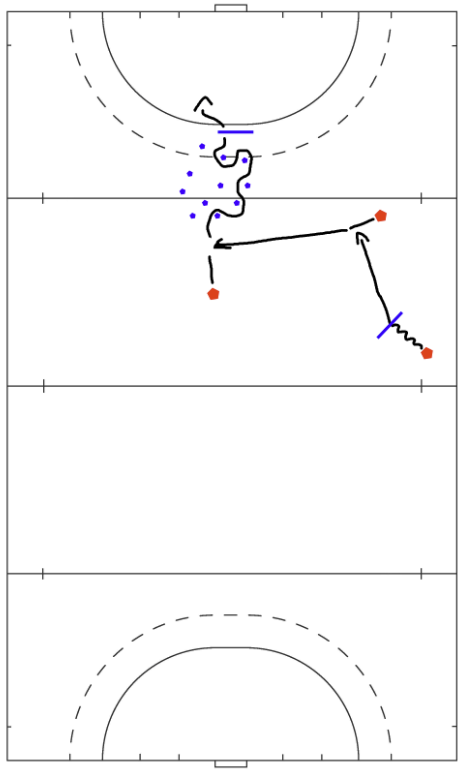
Aim:
- To become physically as well as technically warm as preparation for the training.
Design:
- The exercise will be done with a maximum of 4 people.
- Of course you can put a multiple of these so that the exercise still works.
- The players 1 start with the ball and play it to their players 2. Then they change positions.
- Players 2 play the ball back to players 1 and also change positions.
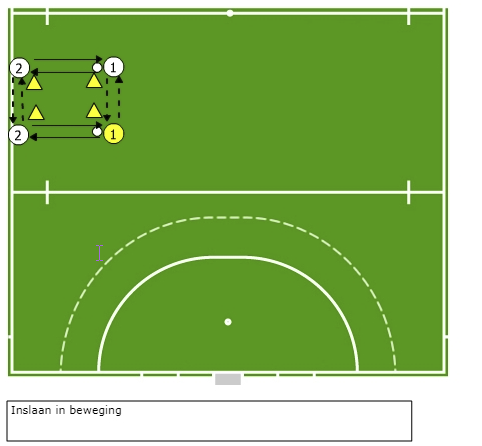
Variations:
- You can vary the way of passing (hitting, push, flats)
- Increase the distance between the pilons so that one only has to walk further.
- Increase the distance between the pilons so that one only has to move on.
- Increase both distances.
- Increase speed
- Make as many successful passes as possible in time.
Points of attention:
- Sit low for good control.
- Stick to the ground at ball control.
- Play ball on the forehand side.
- Stand still at ball acceptance.
- Put out gates of pilons (2 meters wide). from sideline to sideline.
- Players get 3 balls on the sideline
- any ball they can pass through a gate
- In advance, the player indicates which gate he is going to play through
- Each gate has points, the further the gate the higher the points:
- 10 Meter gate = 1 point
- 15 meter gate =5 points
- 20 meter gate = 10 points
- 30 meter gate is =20 points
- 40 meter gate = 30 points
- See how many points each player scores, this makes it clear to the players that a long-distance pass is often not very accurate.
- In addition, you can show that pushing and flatting can be much more convenient than hitting.
- You can put (depending on the level) a square of 3M x3M on the field and if the players score and the ball lands in the square it is worth 50 points.
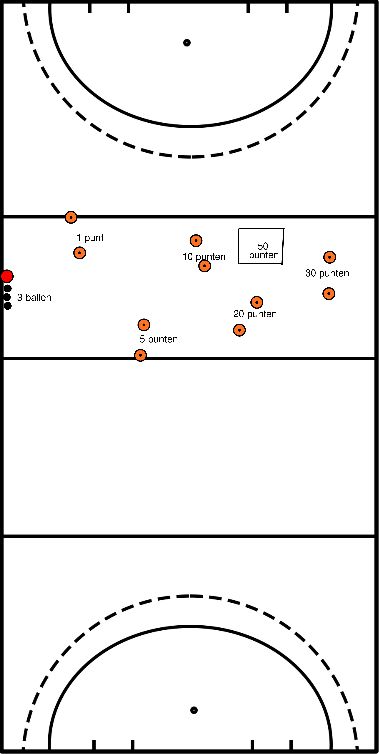
- You start with 3 teams, A, B and C.
- The game will be played on about half a field,
- the ball divider/referee is in the centre of the field in a marked square,
- this square can't be played through.
- There is a goalkeeper in the goal and two goals on the half way line.
- Team A starts defending,
- team B is attacking,
- team C is divided over the 2 small goals.
- Team A has to make sure the ball reaches team C.
- At this moment team B is defending and attacking team C.
- Put the pilons as shown in the figure
- Spread the balls over pilons C and D.
- In this exercise you place a player at pilons C and D.
- The rest of the team will line up at pilon A.
- From A onwards, the player walks around the pilon
- From the post, the player makes a sideways movement facing the ball (facing C).
- Player C plays the ball in the forehand of A
- A takes the ball and turns right open
- A runs in the direction of the circle and finishes at goal.
- From here he runs to D and receives another ball.
- The player turns open to the left and finishes on goal again.
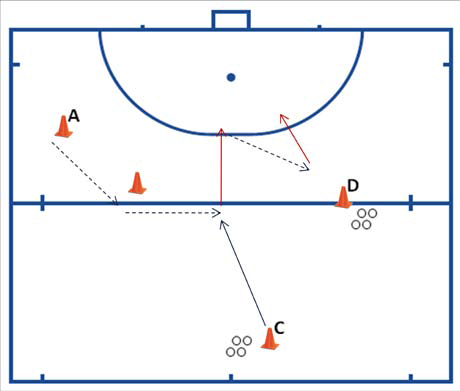

- On the 23 meter line all field players are ready with all balls.
- They play the ball to point D to the left of where a player is ready.
- He plays the ball through and towards the circle to the player from whom he got the ball.
- The player standing at point D calls the player to finish the ball with a backhand or forehand.
- The ball must be hit at the head of the circle on target.
- At point D there are two players and as soon as you have shot on goal you stand in this row.
Passing and scoring
- Each pilon has a player on it.
- Player A plays wide to the left to player B and chases the ball.
- Player B plays the ball diagonally to the right to player C and chases the ball
- Player C plays wide to the left to player D and chases the ball
- Player D plays diagonally to the right the ball to player E and chases after the ball
- Player E takes on and scores with flat / stroke
- Player E continues to the left around the extra pilons (out of practice) back to position A
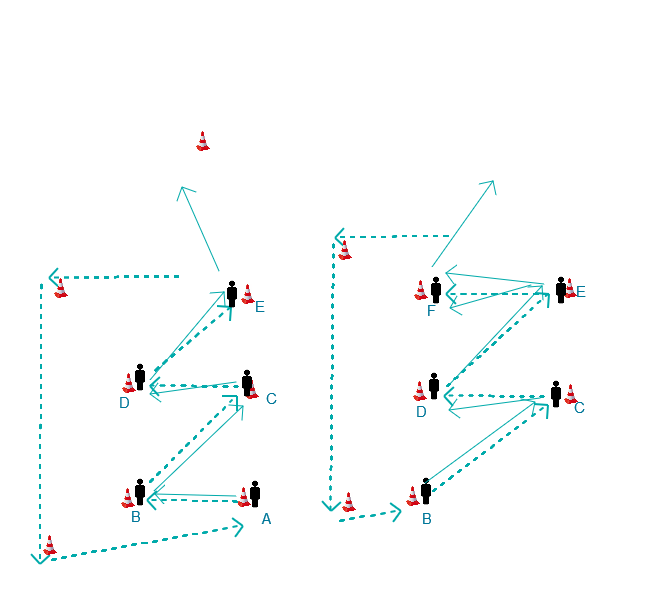
Variation:
- Balls start on the left from position B (pilon/position A is omitted), before that a pilon is added to the edge circle (position F).
- player 1 plays the ball from position B diagonally to the right to player 2 at position C and chases the ball
- Player on C plays wide to left to player in position D and chases after the ball
- Player in position D plays the ball diagonally to the right to player E and chases after the ball
- Player in position E plays wide to the left to player in position F and chases the ball
- Player in position F takes on the fh or high bh and scores with a (backhand) stroke and
- Runs outside the exercise to start position (B)
Variation 2:
- 2 rows of players behind pilons A and B
- Player 1 plays the ball wide to the left and runs straight to position C
- player 2 takes the ball and plays player 1 diagonally to the right in the fh while running (towards position C) and runs straight ahead towards position D.
- player 1 takes the ball in the fh around position C and plays the ball wide / backwards back to player 2 (towards position D) and runs to position E
- player 2 takes the ball (preferably with fh) and with foot position in direction E and plays the ball diagonally forward back to player 1 (direction E: rather just in the circle / edge circle than behind player 1)
- player 1 takes on and strikes / fats as fast as possible towards goal (do not bring the ball back) and runs outside exercise back to position B
Variation on 2:
- After that player 2 has delivered the ball to player 1 the 2nd time / last time, he / she becomes (passive) defender at the next set
- the defender is not allowed to go into the circle (or rather not even behind the line (position C/D) from where he/she started (position D)
- takes off the ball then floats over a line between position A and B.
- The 2 players that come up stay inside the box (width of pass lines) but are free in construction, they may also cross behind, cross over but no passes in the air (no lifts).
- the No. 1 scores and, just like the defender, runs outside back to another position. The No. 2 becomes defender
Accents:
- hands apart while controlling
- foot positioning open
- control it for a follow-up pass or even a quick bounce back
- Score after 2 contacts (control, max 1 other touch)
- see hands/feet position/distance from the ball at hitting and flats accents








